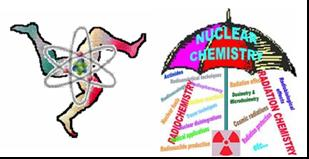Speaker
Ms
Julia Bisson
(CEA-Marcoule, France)
Description
In the context of nuclear fuel reprocessing and in order to reduce the nuclear waste radiotoxicity, new ways to selectively extract actinides from spent fuels are studied. Among them the GANEX process (for Group ActiNides Extraction) is based on a homogenous recycling of actinides. All actinides (U(VI), Np(V et VI), Pu(IV), Am(III), Cm(III)), present in a highly acidic aqueous solution, would be extracted together and separated from fission products (especially from lanthanides) using liquid-liquid extraction. To develop this process, new extracting molecules which can efficiently separate actinides from fission products must be found. The CEA strategy is to synthesize bitopic ligands combining inside the same molecule a nitrogen ring allowing the An(III) / Ln(III) separation and an amide group allowing the extraction of other oxidation states of actinides. Considering previous results, nitrogen rings have been chosen from the 2,9-dipyridyl-1,10-phenanthroline and from the 2,4-dipyridyl-1,3,5-triazine family.
Fourteen new bitopic ligands have thus been synthesized. Four of them (the lipophilic ones) have been tested as liquid- liquid extractants dissolved alone in the organic phase and the results show that ligands from the phenanthroline family are able to selectively extract actinides at different oxidation states from an aqueous solution 3M HNO3 with high distribution ratios and high separation factors toward Eu(III). Ligands from the triazine family are selective but distributions ratios are much lower.
In order to better understand the driving force of the selectivity, thermodynamic studies have been carried out in MeOH-water solutions to determine stability constant for ten hydrophilic ligands. The results confirm the selectivity of ligands towards actinides(III) with respect to lanthanides(III) but also the effect of the structure on the complexation and the selectivity. The speciation (1:1 complexes) has been checked by different techniques like electrospray ionization mass spectrometry.
Author
Ms
Julia Bisson
(CEA-Marcoule, France)
Co-authors
Mr
Didier Dubreuil
(University of Nantes, France)
Mr
Manuel Miguirditchian
(CEA-Marcoule, France)
Mrs
Marie-Christine Charbonnel
(CEA-Marcoule, France)
Ms
Muriel Pipelier
(University of Nantes, France)
Ms
Virginie Blot
(University of Nantes, France)
